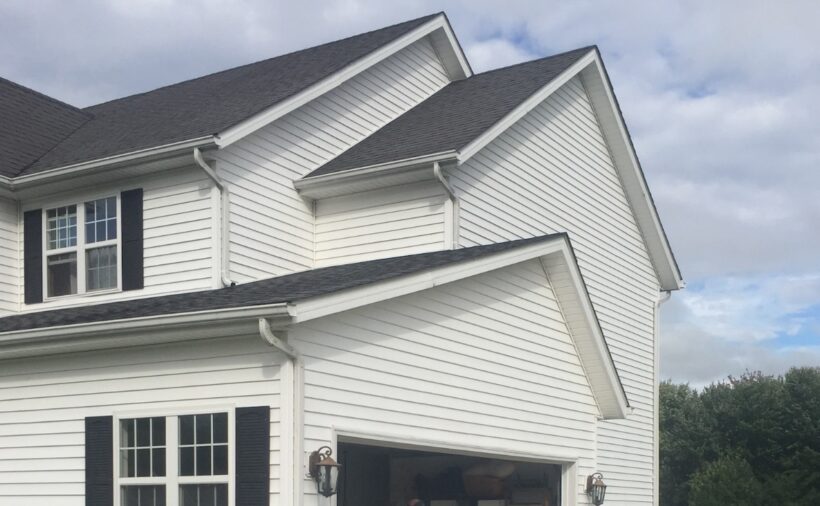Hip roof and gable roof full review
When getting a new home, you may wonder what’s the best option for your roof: a hip roof or a gable roof? Take a look at our guide in order to understand all the pros and cons of each so that you can decide which one you should get for your new house.
What’s a hip roof?
First, a hip roof has no vertical borders. It is sloped on all sides, in other words, if the structure is squared, the slopes will meet at a peak. In fact, the “hip” refers to the outer angle formed where the 2 adjoining sides meet. Moreover, their design is pretty complex and requires good construction knowledge.
Here are the 4 main types of hip roofs:
- What’s a Simple hip roof? This one has a ridge in its middle-top portion, which forms 2 trapezes and 2 triangles.
- What’s a cross-hipped roof? This version of the hip roof is easy to explain, but difficult to describe in detail. Just imagine you would stick 2 simple hip roofs together, and there you have it! You get a cross-hipped roof, which will look like the letter ‘L’ or ‘T’ most of the time.
- What’s a Half hipped roof? Very similar to the simple hip roof’s concept, the main difference is that the 2 sides of the roof are shortened in order to create eaves, or in other words, trapezes instead of being 2 triangles. This type of roof is commonly used for bigger houses.
- What’s a pyramid roof? And finally the most simple one, a pyramid roof. As the name suggests, this roof is made of 4 triangle sides that all meet at one central point. The base is either a square or a rectangle, creating a pyramidal effect.
What is a gable roof?
To begin with, the gables are the small sides of your roof, so for example, the gables of a simple hip roof are the 2 triangles on each end side of the latter. Now, you may wonder what’s the difference between a hipped roof and a gable roof? The answer is simple, the gable roof will always have at least 2 vertical sides, whereas a hip roof only has sloped sides.
Here are 5 types of gable roofs:
- What’s a box gable roof: The box gable roof has a triangular side at each end, the latter being slightly boxed with a horizontal line.
- What’s a front gable roof? A front gable roof is normally used in, snare roll, front of the house! The little roof you see over the entrance door, that’s most likely a front gable roof.
- What’s a cross gable roof? A bit like the crossed hipped-roof, just imagine you join 2 simple gable roofs together, and voilà! You should be able to spot this type of roof when you see 2 or more gable rooflines that are intersecting at an angle, forming a + shape or an L shape.
- What’s a gable roof with a shed roof addition? When you see a lower addition to the gable roof, for protecting a balcony or something along those lines, that’s usually a shed roof addition.
- What’s a Dutch gable roof? And finally, this one is basically a hybrid between a gable and hip roof. The latter is easily noticeable with its small triangular gables on each side.
Which one is better: Hip or Gable roof?
Nowadays, hip roofs and gable roofs are common roof styles used across the world. Here are the pros and cons of each:
Advantages of hip roofs:
- These roofs improve the curb appeal of your house.
- The eaves and gutters are consistent all the way around.
- Hip roofs can be combined easily to form great roof designs.
- They are built appropriately for high winds or heavy snow areas.
- Since their design is self bracing, they require less diagonal bracing.
Disadvantages of hip roofs:
- The fact that they are complex to build makes them more expensive.
- The attic space is reduced because of the sloped sides.
Advantages of gable roofs:
- A big advantage is that they are less expensive than hip roofs (normal since they are less complex to build).
- Gable roofs provide better ventilation, thanks to the gable vents.
- Similar to hipped roofs, their shapes are easily combinable and can form nice roof designs.
- Whereas one of the biggest downfalls of hip roofs being the restricted attic space, gable roofs have plenty of the latter.
Disadvantages of a Gable Roof
- These roofs are not really designed to withstand high wind environments.
In conclusion, the best roof type for your home will depend on various factors, such as the location, the climate, your budget, and of course, on what you want for your house’s final design. In order to get a good idea of what to look for, we recommend speaking to a licensed roofing contractor before anything. Finally, you can also take a quick look around the newer developments nearby to get ideas on what type of roof you should pick.

No Comments